Types of Japanese Flowers (Hanakotoba) – Names, Meaning and Pictures

Flowers play a vital role in Japanese culture, which is expressed in the language of Hanakotoba. Most flowers in Japan have a special symbolic meaning. Some of the most beautiful Japanese flowers are Sakura (cherry blossom), Tsubaki (camellia), Ume (flowering apricot tree), Sumire (violet), and Sakurasou (Japanese primrose). According to the Hanakotoba (Japanese “language of flowers”) – flowers contain secret messages and can communicate powerful messages.
Of course, flowers have different meanings in many cultures. For example, red roses are often the symbol of love, and white roses can signify a new beginning. In contrast, dark crimson roses are associated with mourning. However, in Japanese culture, flowers have an even deeper, more significant meaning.
This article is a guide to the Japanese “language of flowers”—Hanakotoba. You will learn about some of Japan’s most stunning flowers and their secret code, symbolism, and meaning.
What Is Hanakotoba?
Hanakotoba is the unique Japanese language of expressing intentions and emotions through flowers. Flower colors and arrangements have special meanings and feelings that can only be expressed through flowers. Each blossom has its own symbolism and code that makes Hanakotoba one of the world’s most unique languages.
In Hanakotoba, it is possible to express your innermost thoughts and intentions through flowers without any words. The flowers colors, shape, height, and presence of thorns all communicate certain emotions. It is said that Hanakotoba is one of the oldest ways to convey expressions through flowers.
Japanese Flowers (Hanakotoba) with their Name and Meaning
Let’s look in more detail at some of the most popular flowers in Japan associated with Hanakotoba. For each flower, you will find out its special meaning in Hanakotoba.
Tsubaki – Camellia (Camellia japonica)

Red camellia flower symbolizes love in Japanese Hanakotoba
Tsubaki or camellia is a beautiful showy flower. According to the Jappanese language of flowers (Hanakotoba) camellia can mean perfect love, humility, or discretion. Depending on the camellia’s color, Tsubaki has different meanings. White camellia means waiting, the yellow camellia is longing, and red camellia implies love.
Japanese camellia (Tsubaki) is often called the rose of winter. Camellia japonica is a flowering shrub that grows up to 20 ft. (6 m) tall. The showy flowers can be single, semi-double, or double blooms and look like peony flowers. The large flowers range in color from soft pink to dark crimson red blooms. Grow Japanese camellias in USDA zones 6 through 10.
Sakura – Cherry blossom (Prunus serrulata)

Cherry blossom (Sakura) is the national flower of Japan
In Hanakotoba, Sakura or cherry blossom trees symbolize the beauty of heart and accomplishment. The light pink and white blossoms fill cherry trees when they bloom in spring. The showy, delicate flowers droop down in small clusters, creating spectacular displays that are famous throughout Japan.
The Japanese cherry blossom tree or Sakura is synonymous with Japanese culture. Sakura is the national flower of Japan. Festivals in Japan to celebrate the beautiful Sakura blossoms are called sakura matsuri.
There are many varieties of cherry blossom trees, and Prunus serrulata is the most common one. Cherry blossom trees grow between 8 and 40 ft. (2.5 – 12 m), depending on the cultivar.
Related reading: Dwarf cherry trees for backyards.
Sakurasou – Japanese primrose (Primula sieboldii)
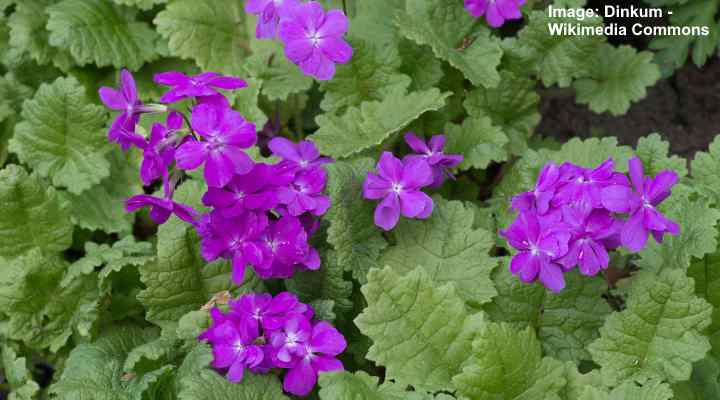
Japanese primrose flower (Sakurasou) symbolizes in Hanakotoba long-lasting love. In the picture: Primula sieboldii ‘Memory’
Sakurasou is commonly known as the Japanese primrose, and the deep magenta or purple flowers symbolize long-lasting love in Hanakotoba. The Japanese name Sakurasou comes from the flower’s resemblance to Sakura. The five-petalled magenta-colored daisy-like flowers bloom profusely in spring. The Japanese primrose is a popular shrubby flowering bush in Japan.
Other common names for Sakurasou include Geisha girl, Madam butterfly, cherry blossom primrose, and snowflake.
The Japanese primrose is a perennial flowering plant that grows up to 18” (45 cm) tall. This delightful plant grows best in mixed beds and flowering borders. Grow in partial sun in USDA zones 4 through 8.
Roses (Rosa)

Momirobara (Pink Rose) expresses confidence, happiness, or trust in someone
As in Western culture, red roses—Akaibara—symbolize love in Hanakotoba. Rose bushes are common in Japanese gardens, and they are popular floral gifts when someone wants to express their deepest feelings. Rose flowers come in various shapes, sizes, and colors.
Here are what the colors of roses mean in the “language of flowers:”
Akaibara (Red Rose)
Akaibara or red rose is the classic symbol of deep love in Western and Asian cultures. Gifting someone a bunch of red roses expresses love, passion, and deep affection.
Shiroibara (White Rose)
Shirobara or white rose is a way of expressing devotion, innocence, and silence.
Kiiroibara (Yellow Rose)
In Hanakotoba, Kiiroibara or the yellow rose has the meaning of jealousy.
Momirobara (Pink Rose)
In Japan, if you want to express confidence, happiness, or trust in someone, then the way to say it is with Momirobara. A gift of pink roses can express your feelings for someone without any romantic connection.
Ume – Apricot Tree Blossom (Prunus mume)
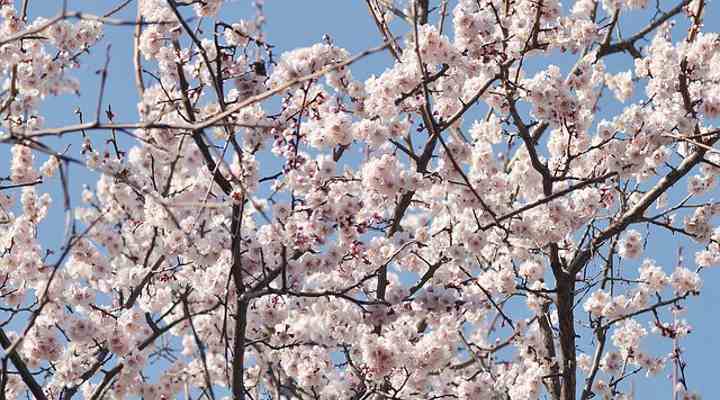
Apricot tree blossom is called in Japanese Ume and means faithfulness, pure heart, and elegance
Ume or the pale pink or white flowers on the blossoming apricot tree have the meaning of faithfulness, pure heart, and elegance in Hanakotoba. Similar to Sakura, it is a spectacular sight when Ume is in full blossom. The sweet honey floral scent of the light pink or white flowers fill parks with delightful aromas.
Prunus mume is also called Japanese plum or Japanese apricot. Flowering apricot trees grow between 13 and 33 ft. (4 – 10 m) and bloom with delicate showy flowers that are 1” (2.5 cm) in diameter. Depending on the apricot tree species, flowers can be pink, white, or red.
Himawari – Sunflower (Helianthus)

Sunflower is a popular Japanese flower symbolizing loyalty, longevity, and adoration in Hanakotoba
Himawari, or the sunflower, is popular in Japanese flower due to its large yellow flowers that mean loyalty, longevity, and adoration in Hanakotoba. Every year in Japan, Himawari is celebrated in the Himawari Matsuri festival dedicated to the giant yellow flowers.
Sunflowers grow as annuals or perennials, depending on the climate. The tall, sun-loving flowers can grow up to 10 ft. (3 m) tall, and the enormous daisy-like flowers can be over 12” (40 cm) in diameter. Sunflowers are hardy in zones 2 through 11.
Asagao – Morning Glory (Ipomoea)

Morning glory (Asago in Hanakotoba) means short or long lasting love
Asago in Hanakotoba is known as Morning Glory in English. The short-lasting trumpet-like flowers bloom in the morning and close by late afternoon. Because of each flower’s short blooming time, Asagao represents brief love in Japanese culture. However, because the beautiful plant blooms continuously from spring until fall, the plant can also mean a long-lasting bond of love.
Morning Glory or Asagao is a twining evergreen vine that has vigorous growth. The vines have velvety, heart-shaped leaves and clusters of flowers in blue, white, purple, white, and deep red. Morning Glory is only suitable for growing in zone 9 and above.
Momo – Peach Tree Blossom (Prunus persica)

Ornamental peach tree blossoms (Momo) symbolize in Japanese culture fascinating personality
Momo are the flowering peach tree, and its showy pink peach blossoms symbolize a fascinating personality. The peach flowers are associated with Hina Matsuri or Girl’s day in Japan, where it’s said that they ward off evil spirits.
Ornamental peach trees, or Momo, blossom in late March and early April. The showy pink flowers have clusters of ruffled petals that cover the tree in spring. Ornamental peach trees are grown for their blossoms because their small fruit is inedible.
Kiku (Chrysanthemum)

The beautiful chrysanthemum flowers have important place in Japanese culture and the imperial family
Kiku or chrysanthemum has stunning large flowers that have a special place in Japanese culture. In Hanakotoba, Kiku is associated with nobility, longevity, trust, and purity. Because of this symbolism, chrysanthemum flowers feature in many aspects of the Japanese imperial family and emperors. Many kimonos also feature Kiku flowers.
Chrysanthemums bloom in the fall, and the plants produce large, showy flowers. Also called ‘Garden Mums,’ flowers can be large double flowers that look like pompoms or star-shaped flowers like daisies. Chrysanthemum flower colors can be red, coral, yellow, pink, or white.
Kosumosu (Cosmos)

Cosmos (Kosumosu) is a popular Japanese flower that symbolizes love and cleanliness
Kosumosu is a popular flower in Japan that symbolizes love and cleanliness in Hanakotoba. The dainty daisy-like flowers sit at the end of thin stems that grow around 6 ft. (1.8 m) tall. Kosumosu is a hardy annual that can grow in zones 2 through 11. The flowers bloom throughout the summer until the fall.
Kinmokusei – Sweet Osmanthus (Osmanthus aurantiaca)
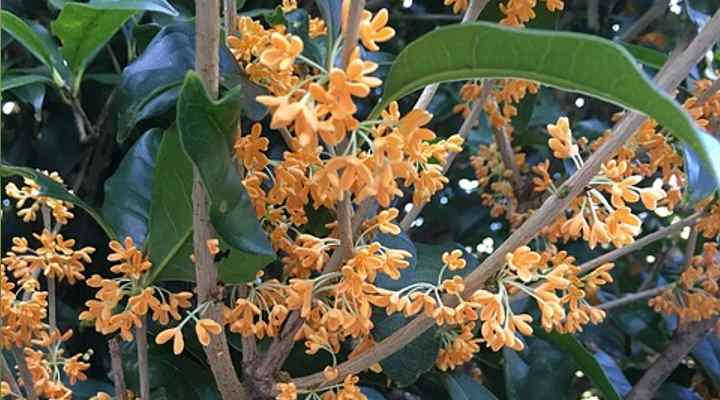
Sweet osmanthus symbolizes in Hanakotoba truth and trustworthiness
The orange flowers of Kinmokusei in Hanakotoba symbolize truth and say that a person is noble and trustworthy. Known as sweet Osmanthus, sweet olive, or tea olive, this fragrant evergreen shrubby bush has clusters of orange flowers. Some Kinmokusei species also have white or yellow flowers.
Kinmokusei is native to Asia and grows throughout China, Japan, and Southeast Asia. In some cities in Japan, Kinmokusei is the official “city tree.”
Magunoria (Magnolia)

Star magnolia is the most popular magnolia variety in Japanese culture
Magunoria has brilliant white flowers that represent natural beauty in Japanese culture. In the West, Magunoria is known as the beautiful magnolia shrub. Magnolias grow as small trees or large shrubs and can have evergreen or deciduous foliage. Some species of magnolias grow tulip-like flowers that are up to 12” (30 cm) across.
The Star magnolia (Magnolia stellata) or “Shidekobushi” in Japanese is the most popular magnolia variety. The stunning white flowers form the shape of a star.
Related reading: How to care for magnolia shrubs.
Renge – Lotus (Nelumbo nucifera)

Lotus flowers express in Hanakotoba love, chastity, and purity, or being far away from a loved one
In Hanakotoba, Renge, or lotus flowers, has the meaning of being far away from a loved one. In Japan, you can also add lotus flowers (Renge) to floral displays to express love, chastity, and purity—very fitting if you are separated from someone you love. The stunning aquatic pink flower floats on the surface of ponds and water gardens.
Exotic lotus flowers grow on the end of long stems from rhizomes in the pond’s bed. The stunning tropical-looking flowers can grow up to 12” (30 cm) across, and the floating leaves are even larger—up to 24” (60 cm) wide.
Haibīsukasu (Hibiscus)
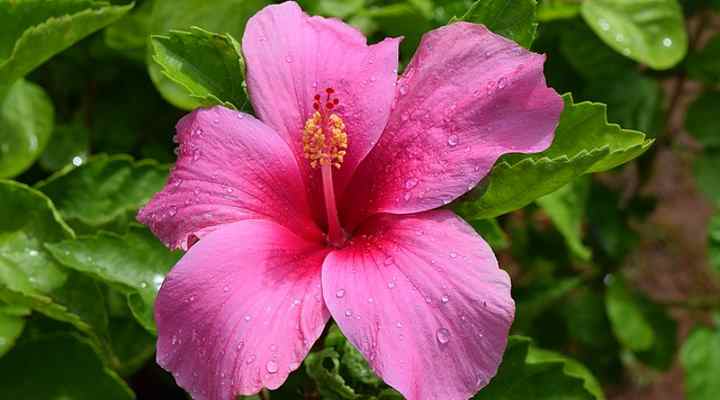
Chinese hibiscus (Hibiscus rosa-sinensis) is the most common hibiscus plant in Japan
Haibīsukasu has delicate red or pink papery petals that are a fitting way to express gentleness towards a person. For example, a hibiscus flower on clothing would represent someone gentle rather than power or respect. The most common hibiscus plant in Japan is the Hibiscus rosa-sinensis, or tropical Chinese hibiscus.
Tropical hibiscus plants only grow in USDA zones 9 through 12. Hardy hibiscus species such as the Rose of Sharon grow in zones 5 through 9. Hibiscus trees and shrubs are ideal flowering plants for any sunny backyard to enjoy tropical flowers all summer long.
Tenjikubotan (Dahlia)
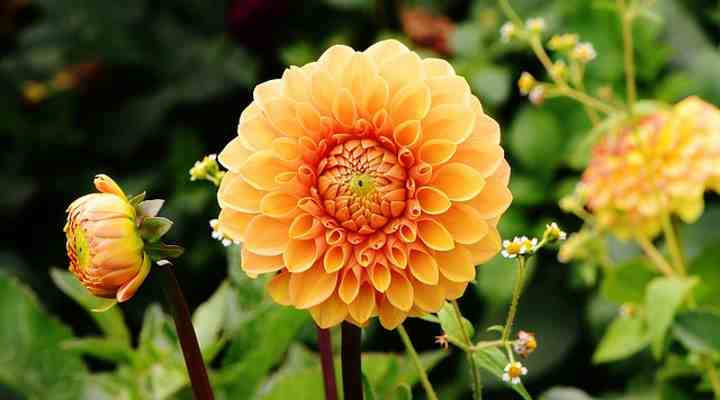
Dahlia flowers mean “of good taste” in Japanese culture
Tenjikubotan means “of good taste” in Hanakotoba, a fitting symbol of the spectacular dahlia flowers. Dahlia shrubs are large bushy flowering plants with huge flowers. Some dahlias have flowers like chrysanthemums, and others have double flowers with thin tapered petals that look like the sun’s rays.
Dahlias grow in USDA zones 8 through 11 and bloom during summer and fall. The flowering shrubs grow best in full sun when planted in groups. That way, you can enjoy the masses of large flowers throughout the summer.
Ajisai (Hydrangea)

The stunning hydrangea flowers express sorry or gratitude according to the Japanese Hanakotoba
Ajisai is the flowers from hydrangeas, and they are an appropriate way to say sorry or express gratitude. So, if someone has done you a favor or you want to make peace, a bouquet of hydrangea flowers will express your feelings beautifully. The gorgeous flowering shrubs bloom in the rainy season during June and July.
Native hydrangea shrubs in Japan go back centuries. Many Japanese temples feature hydrangea gardens.
Hydrangeas are easy to grow flowering shrubs. Hydrangeas produce show-stopping clusters of flowers that add blue, pink, purple, red, and white colors to summer gardens. You can grow hydrangeas in any type of soil, and they are perfect for foundation plantings, containers, or shrub borders.
Kaneshon – Carnation (Dianthus caryophyllus)

Carnations symbolize maternal or familial love in Hanakotoba
Kaneshon or carnations are a symbol of love in Hanakotoba, especially maternal or familial love. Usually, carnations are gifts between family members to show that you care and appreciate your parents or siblings. Carnations are also popular flowers to express feelings in many cultures to show fascination, love, and distinction.
Carnations or Kaneshon are showy flowers with ruffled petals that create spectacular blooms. There are hundreds of varieties of carnations that have single, semi-double, or double flowers. The most popular carnation color that symbolizes love is the red carnation. However, carnation flowers can be white, pink, green, or multi-colored blooms.
Carnations thrive in full sun and grow well in USDA zones 5 through 10.
Shobu – Japanese Iris (Iris ensata)

The elegant Japanese iris (Shobu) means good news and loyalty. In the picture: Iris ensata
Shobu is the Japanese iris flower – it’s a stunning flower to express glad tidings, good news, and loyalty. The elegant Japanese iris flowers are reminiscent of orchid flowers with ruffled, papery purple petals and a yellow stripe in the center. Japanese irises are unique with their larger lower petals and shorter upper petals, and sword-shaped leaves.
The three species of irises native to Japan are Hanabshobu (Iris ensata), Ayame (Iris sanguinea), and Kakitshuata (Iris laevigata).
Japanese iris flowers are easy to grow and survive well in medium to wet soil. These Asiatic irises are taller than other types of irises and grow up to 4 ft. (1.2 m) tall.
Akaichurippu – Red Tulip (Tulipa)

Red tulips (Akiachurippu) express eternal love and passion in Hanakotoba
In Hanakotoba, you can express eternal love as Akiachurippu, which are red tulips. Red tulips are also an appropriate floral gift to wish someone fame. In many cultures, red tulips are also associated with true love or undying passion.
Tulips are bulbous plants that are associated with springtime. There are over 3,000 varieties of tulips with many variations in flower shape and color. The classic tulip flower shape is the cup-shaped flower with rounded petals. However, tulips can also have pointed petals, double bowl-shaped flowers, and lily-like flowers.
Sumire – Violet (Viola)

The delicate violets flowers express sincerity, love, and bliss in Japanese culture
Sumire (violet) flower has the meaning of sincerity, love, and bliss, and you can express this with delicate purple violets. Some violet species are cold-hardy in zone 2, but most violets grow in zones 4 through 9. Depending on the climate and species, violets grow as annuals or perennials.
Many varieties of violets have unique markings and patterns. Also, Viola species have some of the most stunning color combinations you will find on any flower. Violets can be purple, orange, light pink, golden yellow, and white. Some eye-catching violets have petals with contrasting color combinations such as dark purple and bright orange.
Rabenda – Lavender (Lavandula)

Lavender symbolizes faithfulness in Hanakotoba
Rabenda symbolizes faithfulness in Hanakotoba, and the lavender is an appropriate flower. Although lavender is associated with the Mediterranean, lavender fields are a popular sight in Japan in the summer. Hokkaido is the island where lavender is famous in Japan. Fields growing purple, yellow, and red lavender make for spectacular sights in Japan.
Lavender plants are small, hardy shrubs that produce spikes of colored, aromatic flowers in summer. Lavender is ideal for growing along herbaceous borders, as foundation plantings, in sunny flower beds, and containers.
Related articles:
